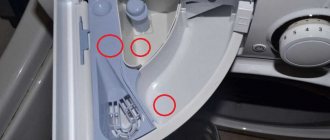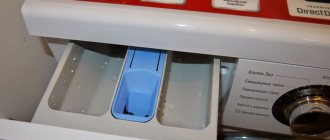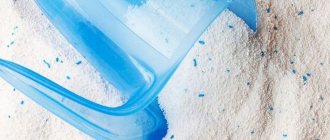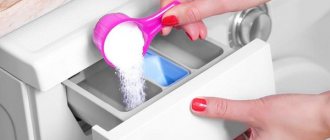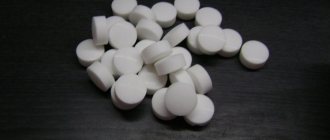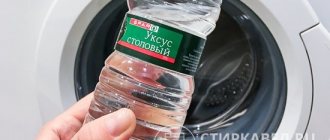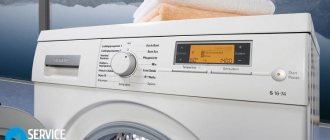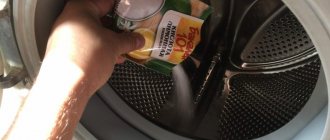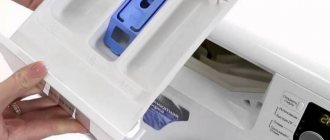Each manufacturer's instructions for using an automatic machine contains information about the rules for loading household chemicals to obtain an effective washing result.
If the documents do not contain a description in Russian, they are lost, or a unit was purchased that was used, tips from professionals and experienced housewives will help you understand the function of the cells in the tray.
We'll tell you in the article where to put the powder (as well as pour the gel, place capsules, tablets, etc.) into the washing machine.
What is the correct way - in which compartment, cell?
All products are loaded into the tray (cuvette) of the washing machine before the program starts . If the housewife forgot to add some product, it can be added later if the washing stage with its use has not yet begun.
The tray is made of plastic. Its front panel has the color of the body, the inside is white or gray.
The retractable cuvette has from 2 to 4 cells. Each performs its own function and is marked for convenience. There is no single system for designations; different manufacturers use Roman, Arabic numerals or Latin letters.
Description of the cells of a typical drawer cuvette:
| Marking | Size | Accessories | Function | What to download |
| 1, I, A | average | none | pre-soak, double wash cycle | powder, starching agent (loose only) |
| 2, II, B | big | curtain | main loop | bulk, liquid detergents, bleaches, stain removers, softeners |
| Softener, *, flower | small | overflow valve | laundry care | conditioner, fabric softener (liquids only) |
The cap marked MAX (overflow valve) is not a dispenser ; it shows the maximum amount of product that can be poured into the conditioner compartment.
A curtain (special partition) in the cell for the main cycle is necessary for the transition from liquid detergent (it is lowered before pouring) to bulk detergent (raised) and vice versa.
The number, structure and location of cells for household chemicals may vary from manufacturer to manufacturer.
What happens if you load it into the wrong compartment?
According to manufacturers and service workers, using the tray compartments for purposes other than their intended purpose will not harm the washing machine . If the housewife mixes up the cells and the powder gets into, for example, the conditioner cell, only the quality of the wash will suffer.
Not only will the laundry not get rid of dirt during the process, but it will also receive a soapy solution when rinsing. This will lead to additional consumption of household chemicals, electricity and water. The unit will have to be loaded again and the wash cycle repeated.
What happens if you put it in the wrong place?
It is not without reason that the powder receptacle is divided into compartments. The whole point is that the machine gradually selects the required amount of detergent in accordance with the specified program. Gradual mixing of powder with water ensures the highest quality and safe washing.
Should we expect serious problems if the powder is poured in the wrong place? No. The only thing that can happen in a situation where the powder is poured into the wrong cell is that the quality of the wash will suffer .
Differences for machines with different loading
A significant difference between top-loading and horizontal-loading washing machines is the location of the tray with cells for detergents, bleaches and softeners.
For units with vertical loading, the container is located directly in the hatch . The downside of such models: you won’t be able to add the product after the program has started; you can stop it temporarily. In modern models, manufacturers have added a reloading function.
For washing machines with side (horizontal) loading, the container for household chemicals is located in the upper left corner of the front wall. You can open the retractable cuvette at any stage of the wash cycle.
Adviсe
Do not pour aggressive detergents (bleaches, stain removers) into the washing drum. Direct contact of chemical reagents destroys not only fabric fibers, but the rubber cuff surrounding the entrance to the washing machine drum.
To protect the walls of the powder receptacle from mold and limescale, after each wash the trays are thoroughly cleaned of undissolved detergent particles. At least once a month, the powder receptacle is removed from the housing and washed under running water with a brush and soap solution.
You should not put the powder dispenser in the drum if you plan to wash at temperatures above 60°C (the plastic may become deformed).
Detailed operating instructions for Indesit washing machines are presented in this section.
Is it possible to pour directly into the drum?
To answer this question, you need to refer to the washing machine manufacturer's instructions.
In most cases, this is not recommended , with the exception of some types of household chemicals for washing children's clothes.
It is strictly forbidden to put stain removers and bleaches into the drum; they are used only in specially designated compartments of the tray.
The granular structure and more aggressive composition of bulk products are not the best option for proximity to fabrics; mechanical damage and partial loss of the original color are guaranteed.
It is better to pour the powders into a special compartment from which it will be washed , dissolved along the way of transportation and evenly distributed in the drum.
If the housewife is sure that the bulk product in the drum will bring more benefits, then it is necessary to place it in a special container (a device in the form of a ball with holes), often included with the washing machine.
How to measure the right amount of powder
All manufacturers give recommendations on the amount of powder required for washing. Most often, they calculate the consumption for a full machine load (4.5-5 kg of dry things). But you shouldn’t wait for the required amount of dirty laundry to accumulate. In order to measure the powder, approximately calculate the weight of the items and compare it with the instructions on the product.
A special glass or spoon will help you measure the powder. If these were not included with the powder, you can use the prompts (divisions) directly inside the tray. With experience, many owners do not calculate the required amount of powder each time, but intuitively pour it into the washing machine compartment.
There is no need for uniform distribution of powder in the tray hopper; the water pressure will wash it away anyway. The main thing is to make sure that it does not scatter past the receiver, this can interfere with the close contact of the tray with the machine and become an obstacle to its full operation.
Dosage
Information on the recommended amount of detergent can be found in the instructions of the manufacturers of household chemicals for washing machines. If it is not possible to study them, there is a proven standard: 1 tbsp. l of powder (25 g) per 1 kg of loaded laundry.
The quantity can be doubled if:
- the degree of soiling of the laundry is high, there are old stains;
- the water quality is inadequate, it is hard;
- A washing program for certain types of laundry requires more water.
In other cases, it is not recommended to exceed the standard, otherwise the unit may fail due to high foaming.
What does the washing powder tray look like and where is it located?
In different models, the container for powders and liquids is located differently. If your washing machine has a vertical loading of laundry, then this compartment will be located on the inside of the hatch; in front-facing machines it is located on the front or rear panel.
The tray consists of 3 parts of different sizes, each of which is marked with icons (different models may have different markings). When loading detergents, you need to focus on these indicators. So what does the tray look like? When you open it, you will see the following:
- the widest compartment is marked with B, "2" or II;
- the medium-sized part of the compartment is designated by the letter "A", the Arabic numeral "1" or the Roman I;
- the smallest part of the container is indicated by an asterisk or a flower, and may have the inscription Softener.
Once you've found the tray and examined it, it's time to figure out which part is for which products.
Where should gels, capsules, plates be placed?
Liquid laundry detergents (gels, concentrates) can be used in several ways:
- In the cell labeled II, 2, B.
- In the drum of a washing machine.
- Place in a special dispenser and send to a load of laundry.
Before loading the product into the drum, you must study the manufacturer's recommendations. In some models this is strictly prohibited.
Direct loading of industrial liquid is undesirable if:
- it contains bleaching particles, direct contact leads to the formation of stains on fabrics;
- the composition contains components that prevent the formation of scale, in this case they do not have an effect;
- The main wash compartment is already loaded with dry powder.
Capsules, tablets, plates are more convenient to use; one piece is enough for washing with a load of up to 5 kg. They are placed directly into the drum before starting the unit, the laundry is placed on top. They dissolve quickly and are distributed evenly.
Washing tablets can also be placed in the main wash compartment . But housewives note that they deal with dirt most effectively when loading them into the drum.
Standard marking of trays for loading detergents and their purpose
There are “washing machines” that are not equipped with a compartment for filling detergents, but if such equipment is present, then it is important to know exactly which section is responsible for what. Often the tray is divided into three containers, masked with a certain symbol. Let's take a closer look.
| Symbol | Explanation and purpose |
| I (1) or A | This compartment is designed to be filled with washing powder or liquid gel detergent. During operation, the washing machine fills this container with water only if the selected washing function provides for pre-cleaning of items. You can also place bleaches and stain removers in this compartment. |
| II (2) or B | This marking indicates that the tray is intended for loading powder or any detergent for the main wash. |
| * ❄ star or snowflake | In terms of size, this compartment is usually the narrowest and smallest; its function is to wash out fabric softeners or fabric softeners. Begins to be used only during the last rinse stage. |
Good to know!
Do not place bleach or stain removers directly into the drum. Even the correctly selected washing mode will not save the item from damage.
Differences in the design of trays between different manufacturers
In most cases, the number and location of cells for detergents and care products is standard: 3 containers in a pull-out cuvette.
But there are exceptions:
- LG sometimes only offers 2 compartments (in older models). Soaking products (small compartment on the right) and care products (insert) are loaded into one compartment.
- The main difference between Indesit is the cuvette for bleaching substances, which has a compartment for liquids and bulk or concentrated (thick) products.
- Some Samsung models have an additional compartment in the prewash compartment. It is designed to load bleach. If the cell is not removed, the pre-soak program cannot be started.
- Most Bosh machines have a starch compartment added. Starch can only be loaded into the cell in the form of a solution with water.
If the location is atypical, markings will help you understand the compartments of the tray for loading household chemicals.
What types of detergents are there and what are they for?
The range of household chemicals stores is wide and varied, and counters with laundry detergents are full of a huge number of bright boxes and bottles. How to figure this out? The main types of washing compositions can be distinguished:
- powders (intended for main wash);
- compositions in the form of liquids (washing gel, rinse aid, stain remover and fabric softener);
- tablets and capsules (contain concentrated compressed laundry detergent or gel).
Whatever product you use, pay attention to the amount of foam formed. If there is too much of it, this indicates that the dose of the substance has been exceeded and needs to be adjusted. Typically, these recommendations can be found on the packaging of the powder or gel.
It is also important to choose products marked “automatic” for machine washing and pour or pour the selected composition only into the appropriate compartment of the tray.
Cuvette care
The tray for household chemicals in a washing machine is an important part and requires additional care, despite constant contact with detergents.
In order for the unit to operate normally, it must be washed and dried to prevent the occurrence of:
- raid,
- mold,
- clogging of filters and pipes.
In modern front-loading machines, the tray can be easily removed using a special button (PUSH) or a plastic lever located in the rinsing compartment. If the listed devices are missing, you should pull the retractable cuvette and it will come out.
Recommendations for processing:
- It is necessary to clean after every 3 washes;
- be sure to use a brush or sponge, special household chemicals;
- You can use folk remedies: citric acid, soda, vinegar, its essence.
You will find a lot of useful and important information about washing powder here.
Determining the optimal amount of funds
Depending on the selected program, the following products must be added when washing products:
- For simple washing, just pour the powder into the cell marked with the letter B or the number 2 (II).
- For a full cycle with soaking and rinsing with the addition of softener, powder is loaded into compartments A and B, and conditioner is poured into the tray marked with 3 or a “flower”.
- If the laundry is not heavily soiled, you can do without pre-soaking. In this case, it is enough to add detergent to compartment B (II); If desired, rinse aid can also be added to the small compartment.
Conditioner (fragrance, rinse aid) can be poured into the tray at any stage of the process until the start of the final stage (rinsing and spinning).
What affects the amount of powder?
The amount of detergent required for washing depends primarily on the volume of items loaded into the machine.
In addition, factors such as:
- degree of soiling of the laundry;
- hardness of water;
- amount of water required for washing;
- selected program;
- washing technology.
The more stains on the products, the higher the consumption of detergent. If the stains are complex, it is better to use a stain remover or bleach.
An alternative to industrial water softeners can be a few tablespoons of baking soda, which is added to the powder compartment. You just need to keep in mind that this product should not be used when washing wool and silk items.
Washing in soft water requires less powder than in hard water. To determine what type of water is in your region, just look at the transparent window when you start washing. If bubbles are visible on it, it means that soft water is flowing from the taps.
The liquid can be softened artificially by adding a special product containing phosphates to the washing powder. A large volume of washing water implies an increased content of detergents.
Different modes involve the use of a certain amount of washing powder. In some cases, the difference can be striking: for example, when washing 3 kg of laundry in the “Cotton” mode at +60 °C, 6 tablespoons of detergent will be required, whereas when choosing the “Synthetics” program at +40 °C, only three are required.
It is also necessary to use liquid gel in a certain amount. Increasing the laying rate only leads to wasteful use of the product, while the quality of washing remains unchanged
Innovative solutions used in modern models of washing machines from the best manufacturers can reduce the consumption of electricity, water, and detergents.
Such technologies include:
- “smart bubbles” EcoBubble;
- steam wash.
In the first case, a special foam generator is used, with which the powder is mixed in water before it enters the drum. Under the influence of bubbles, the product penetrates better into the fabric structure, effectively removing dirt, which helps save powder.
Steam washing involves applying a heated jet of water to items placed in a drum. This technology promotes the rapid dissolution of detergents and the effective removal of contaminants, including old ones.
In this case, the water temperature is chosen arbitrarily; it does not necessarily need to be heated to high temperatures. Important advantages of steam washing include the radical destruction of germs and allergens.
Calculating the proportions of detergent
You should not thoughtlessly pour household chemicals into the washing machine tray. Exceeding the norm threatens increased foaming, which can lead to clogging of the hose and leaks. If you do not calculate the consumption and add little detergent, the laundry may not wash well.
Some expensive models have an automatic detergent dispensing function. In this case, the machine is loaded with a large amount of the substance used for washing, and then it measures the required amount, focusing on the weight of the laundry
We will try to determine exactly how much detergent powder should be poured into the washing machine.
As a rule, the label of any product contains dosage information, and sometimes the manufacturer supplies the pack with a measuring spoon or cup. According to the manufacturers, 115 grams may be required to wash clothes, and even 225 grams for heavily soiled items.
Experience shows that good washing results can be obtained using much less detergent. For lightly soiled items, it is enough to add one heaped tablespoon of powder (25 g) per 1 kg of laundry.
If things are heavily soiled or washing is carried out in very hard water, it is recommended to increase the dose to 1.5-2 tablespoons per kilogram.
It is not recommended to exceed the consumption rate of detergent, not only because of savings: if there is an excessive amount of washing powder, whitish stains remain on things
Concentrated powders, which include Japanese products and Amway products, are beneficial to use. Their proportions are calculated regardless of the amount of laundry loaded: only 2 tablespoons of detergents of this type are sufficient for any cycle.
If you use capsules, you should know that one element is enough for a cycle, regardless of the load.
On the presented table you can see the approximate consumption of washing powder required for various washing modes, taking into account the quality of water
Liquid and gel detergents are usually added at the rate of 1 tablespoon per cycle (regardless of the volume of items); for hard water, it is recommended to increase the amount of detergent to 2 tablespoons.
Where should I put Indesit powder?
Almost all powder trays in Indesit washing machines are similar. They are retractable, located on the left side of the top panel of the machine and have three sections that are used for different detergents and washing modes.
Interesting materials:
Is it possible to stay in a room where a thermometer has broken? Can I cover with foil in the oven? Is it possible to pour boiling water into a glass thermos? Can the base be applied twice? Is it possible to apply waterproofing to a wet wall? Is it possible to apply rubber base in 2 layers? Can oil be applied to dry hair? Is it possible to apply putty on lime whitewash? Is it possible to teach animals to speak? Is it possible to learn to jump higher?
Washing modes
We managed to figure out what a tray is, as well as what compartments are in it and why. Now we have to understand the functionality of a standard washing machine and its modes.
It is very convenient when manufacturers indicate all the necessary information about the features of the modes directly on the working panel. In this situation, there will be no question of where to put the powder in the washing machine.
A standard washing machine has 15 different modes for washing dirty laundry.
washing modes on the washing machine tray
We choose the most popular washing modes that will be useful for every day.
There are three main modes:
- Soaking and rinsing. Fill the large and middle compartments with powder, and also pour a certain amount of conditioner into the small compartment.
- Standard mode. Only the middle tray is filled.
- Normal wash and rinse. The middle and small compartments of the tray are filled with the necessary washing products.
Most often, during everyday washing, the largest compartment is filled with powder, and the small compartment is filled with fabric softener.
Possible difficulties
If the washing powder remains untouched in the tray after washing, and your clothes are quite dirty, this means that problems have arisen during the washing process.
What could be the reasons for such problems?
- We chose the wrong mode for washing. It often happens that a person simply forgets or confuses the modes.
- There were problems with the water supply. You need to check the required valve and the pressure of the supplied water.
- A large amount of powder. More powder has been poured than required by the regime.
- Problems with the dispenser. Difficulties may arise when feeding detergent into the middle of the centrifuge due to the fact that it is simply clogged. You need to remove the container from the washing machine and check its condition.
If you were unable to resolve the problem on your own, then you should definitely turn to specialists for help.
How to restart the Indesit washing machine?
It is performed as follows:
- set the programmer knob to the neutral position;
- press “Stop/Start” for 5 seconds;
- unplug the power cord from the outlet, wait 15-20 minutes;
- reconnect the SMA to the network, launch the desired program.
Interesting materials:
How to kill and skin a rabbit? How to block ads in Chrome? How to block all incoming calls on Tele2? How to collect luggage at the airport? How to enchant a book for loot 3? How to clean walls? How to set priority? How to fix a deep scratch on a car? How to repair chipped enamel in a bathroom? How to fix a scratch on a bumper?
Pros and cons of the alternative method
There are different opinions about adding detergent directly to laundry. Supporters note the following positive aspects:
- In this case, the amount of detergent can be reduced , since it comes into contact with things.
- This method increases the service life of the machine , and also relieves the user of caring for the tray, which is one of the most problematic components of washing units.
- If powder particles get through the ditch, they can stick to the inner walls and then get onto the laundry when rinsing. This does not happen when you put it in the drum, so things are rinsed faster and better.
At the same time, there are a significant number of disadvantages:
- In the compartment, the powder is washed out with water, entering the drum already partially dissolved. When adding the product directly to the laundry, it will take much longer to dissolve.
- Washing powder granules that fall on dark-colored items may leave light marks.
- If the product is poured onto the wall of the drum, then at start, part of it will be pumped out by the pump along with the water remaining in the tank from previous washes.
- Some wash programs that require batch use of detergent will not be available if detergent is added to the drum.
- There is no point in adding powder to the drum when planning a pre-wash or soak. Such modes involve draining the water after passing the initial stage; Along with the liquid, the detergent dissolved in it will also leave, which will not wait until the main stage of the cycle.
- It is also not possible to use this method to add conditioner or other rinse aid, which should only be added at the final stage of the process.
The use of a special container will partially avoid the negative consequences: a plastic jar with holes marked on the lid. The detergent poured into it will flow into the water gradually and will not be washed out immediately. At the same time, this method will not solve the problem of using conditioners or other rinses.
[custom_ads_shortcode1]
